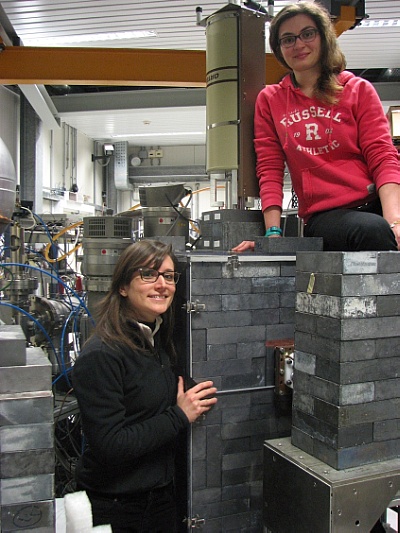The puzzle of the origin of elements in the universe

Dr. Rosanna Depalo (HZDR) and Dr. Francesca Cavanna (left) at the LUNA experiment in the INFN Gran Sasso Laboratory. Foto: R. Depalo, INFN/HZDR. Photo: R. Depalo (INFN/HZDR)
LUNA (Laboratory for Underground Nuclear Astrophysics) is a compact linear accelerator. It is the only one in the world installed in an underground facility, shielded against cosmic rays.
The experiment aims to study the nuclear reactions that take place inside stars where, like in an intriguing and amazing cosmic kitchen, the elements that make up matter are formed and then driven out by gigantic explosions and scattered as cosmic dust.
For the first time, this experiment has observed three “resonances” in the neon-sodium cycle responsible for sodium production in red giants and energy generation (the 22Ne(p,g)23Na. In the same way as in acoustics, a “resonance” is a particular condition that makes the reaction inside the star extremely likely.
LUNA recreates the energy ranges of nuclear reactions and, with its accelerator, goes back in time to one hundred million years after the Big Bang, to the formation of the first stars and the start of those processes that gave rise to mysteries we still do not fully understand, such as the huge variety in the quantities of the elements in the universe.
“This result is an important piece in the puzzle of the origin of the elements in the universe, which the experiment has been studying for the last 25 years”, remarked Paolo Prati, spokesperson for the LUNA experiment.
“Stars generate energy and at the same time assemble atoms through a complex system of nuclear reactions. A very small number of these reactions have been studied in the conditions under which they occur inside stars, and a large proportion of those few cases have been observed with this accelerator”.
LUNA uses a compact linear accelerator in which hydrogen and helium beams are accelerated and made to collide with a target (in this case, a neon isotope), to produce other particles. Special detectors obtain images of the products of the collisions and identify the reaction to be examined. These extremely rare processes can only be detected in conditions of cosmic silence. The rock surrounding the underground facility at the Gran Sasso National Laboratory shields the experiment against cosmic rays and protects its measurements.
LUNA is an international collaboration involving some 50 Italian, German, Scottish and Hungarian researchers from the National Institute for Nuclear Physics in Italy, the Helmholtz-Zentrum Dresden-Rossendorf in Germany, the MTA-ATOMKI in Hungary and the School of Physics and Astronomy of the University of Edinburgh in the UK.
Contact Details:
Dr. Daniel Bemmerer
Institute of Radiation Physics at HZDR, Germany
Phone +49 351 260-23581
Mail: d.bemmerer@hzdr.de
Prof. Paolo Prati
LUNA Spokesperson, INFN
Mobile: + 39 3493951491
Mail prati@ge.infn.it
Eleonora Cossi
INFN – Communications Office
Phone +39 06.6868162 | +39 345.2954623
Mail eleonora.cossi@presid.infn.it
Roberta Antolini
LNGS – External Relations and Scientific Information
Phone +39 0862 437265/450
Mail: antolini@lngs.infn.it
Christine Bohnet
HZDR – Press officer
Phone +49 351 260-2450
Mail: c.bohnet@hzdr.de
Helmholtz-Zentrum Dresden-Rossendorf
Bautzner Landstr. 400, 01328 Dresden, Germany
The Helmholtz-Zentrum Dresden-Rossendorf (HZDR) conducts research in the sectors energy, health, and matter. It focuses its research on the following topics:
• How can energy and resources be used efficiently, safely, and sustainably?
• How can malignant tumors be visualized and characterized more precisely and treated effectively?
• How do matter and materials behave in strong fields and in the smallest dimensions?
Several large-scale research facilities provide unique research opportunities. These facilities are also accessible to external users.
The HZDR has been a member of the Helmholtz Association, Germany’s largest research organization, since 2011. It has four locations (Dresden, Leipzig, Freiberg, Grenoble) and employs about 1,100 people – approximately 500 of whom are scientists, including 150 doctoral candidates.
http://www.hzdr.de/presse/luna
http://journals.aps.org/prl/abstract/10.1103/PhysRevLett.115.252501
Media Contact
All latest news from the category: Physics and Astronomy
This area deals with the fundamental laws and building blocks of nature and how they interact, the properties and the behavior of matter, and research into space and time and their structures.
innovations-report provides in-depth reports and articles on subjects such as astrophysics, laser technologies, nuclear, quantum, particle and solid-state physics, nanotechnologies, planetary research and findings (Mars, Venus) and developments related to the Hubble Telescope.
Newest articles

NASA: Mystery of life’s handedness deepens
The mystery of why life uses molecules with specific orientations has deepened with a NASA-funded discovery that RNA — a key molecule thought to have potentially held the instructions for…

What are the effects of historic lithium mining on water quality?
Study reveals low levels of common contaminants but high levels of other elements in waters associated with an abandoned lithium mine. Lithium ore and mining waste from a historic lithium…

Quantum-inspired design boosts efficiency of heat-to-electricity conversion
Rice engineers take unconventional route to improving thermophotovoltaic systems. Researchers at Rice University have found a new way to improve a key element of thermophotovoltaic (TPV) systems, which convert heat…



